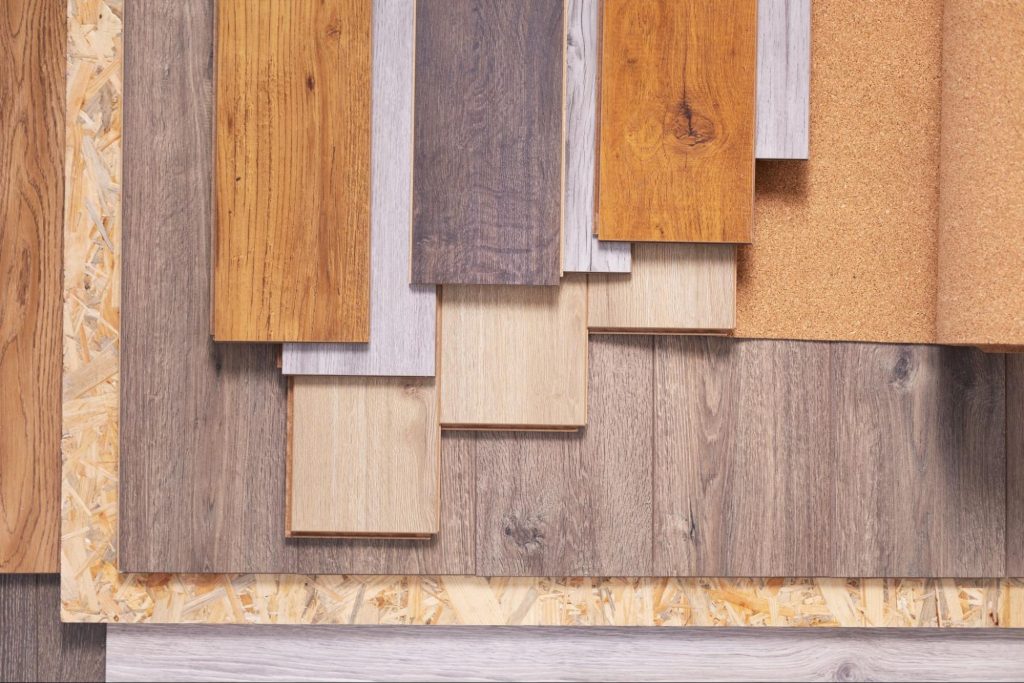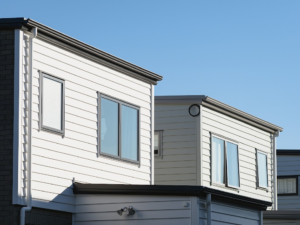Deciding between wood floor laminate and hardwood is a common dilemma for many homeowners looking to update their flooring. Each option brings benefits, making the choice dependent on various factors like budget, lifestyle, and personal taste. Among the most popular options are wood floor laminate and hardwood, each offering unique benefits and drawbacks. While hardwood flooring is renowned for its timeless beauty and durability, laminate flooring is celebrated for its affordability and versatility.
It is understandable if you get confused about which material suits your needs. In this article, we will compare wood floor laminate and hardwood in various aspects to help you determine which option suits your needs and preferences better.
Difference Between Laminate and Hardwood Flooring
Laminate and hardwood are two of the most popular flooring options among homeowners. Each type of flooring offers unique characteristics that can significantly impact your space’s look, feel, and functionality. Understanding the fundamental differences between laminate and hardwood flooring is essential to making an informed decision that suits your lifestyle, budget, and aesthetic preferences.
Composition and Material
Laminate flooring is a synthetic product made up of multiple layers. The base layer is typically composed of high-density fiberboard (HDF), which provides stability and strength. Above this base layer, a photographic layer mimics the appearance of natural wood, followed by a clear protective coating that guards against wear and damage. In contrast, hardwood flooring is made from solid pieces of natural wood, such as oak, maple, or cherry. This natural composition gives hardwood unique grain patterns, rich textures, and durability.
Appearance and Aesthetics
One of the most noticeable differences between laminate and hardwood flooring is their appearance. Hardwood floors are prized for their natural beauty, with each plank offering unique variations in color and grain. This authentic look can add warmth and elegance to any room. On the other hand, laminate flooring is designed to imitate the look of hardwood but often lacks the depth and texture of real wood. While modern laminate can closely resemble hardwood, it may still fall short in replicating natural wood’s intricate details and organic feel.
Durability and Longevity
Durability is a critical factor when choosing flooring, and laminate and hardwood have their strengths. Hardwood floors are renowned for longevity and can last decades with proper care and maintenance. They can be sanded and refinished multiple times to remove scratches and restore their original appearance. Laminate flooring, while highly resistant to scratches, dents, and moisture, does not offer the same level of longevity. Once damaged, laminate cannot be refinished and may need to be replaced. However, its robust top layer makes it a practical choice for high-traffic areas and homes with pets and children.
Installation Process
The installation process for laminate and hardwood flooring is significantly different. Laminate flooring is designed for easy installation, often featuring a click-lock system that allows the planks to snap together without needing nails or glue. This makes it a popular choice for DIY enthusiasts and those looking for a quick and cost-effective installation. Hardwood flooring, however, requires a more complex installation process. It typically involves nailing or gluing the planks to the subfloor, which can be time-consuming and often requires professional expertise. Understanding these installation processes can help you decide if you’re up for a DIY project or if you need to hire a professional.
Cost Considerations
Budget is a crucial consideration for many homeowners when selecting flooring. Laminate flooring is generally more affordable than hardwood in terms of material costs and installation expenses. Its synthetic composition and straightforward installation process contribute to its lower price point. Hardwood flooring, a natural and premium product, comes at a higher cost. However, this investment can add significant value to your home, making it worthwhile for those looking to enhance their property’s appeal and resale value.
Understanding the main differences between laminate and hardwood flooring is essential. With this knowledge, you can choose the option that best fits your requirements and tastes. Hardwood offers unmatched beauty, longevity, and value, while laminate offers affordability, ease of installation, and durability. Considering factors such as composition, appearance, durability, installation, and cost, you can select the flooring option that best suits your lifestyle and enhances your home.
Five Differences Between Wood Floor Laminate and Hardwood
Choosing the right flooring for your home involves evaluating several factors, including durability, cost, appearance, and maintenance. Wood floor laminate and hardwood are two popular options, each with distinct characteristics. This section will delve into five key differences between wood floor laminate and hardwood, providing a comprehensive understanding to help you decide which flooring type is best for your home.
1. Material Composition
The primary difference between laminate and hardwood flooring lies in their material composition. Laminate flooring is engineered from high-density fiberboard with a photographic layer that replicates the look of wood, topped with a clear protective coating. This multi-layer construction provides durability and resistance to wear. Hardwood flooring, on the other hand, consists of solid wood planks made from various species of trees. This natural composition gives hardwood its unique and authentic appearance, with each plank showcasing distinct grain patterns and textures.
2. Visual Appeal and Authenticity
Regarding visual appeal, hardwood flooring is often considered superior due to its natural beauty and authenticity. The rich textures, varied grain patterns, and natural color variations of hardwood create a warm and elegant atmosphere in any room. While laminate flooring has significantly improved in mimicking the look of natural wood, it often lacks the depth and organic feel that genuine hardwood provides. However, laminate offers a wide range of styles and finishes, allowing homeowners to achieve the desired look at a lower cost.
3. Durability and Maintenance
Durability is another critical factor that distinguishes laminate from hardwood flooring. Laminate flooring is highly resistant to scratches, dents, and moisture, making it an excellent choice for high-traffic areas and households with pets or children. Its top protective layer ensures that it can withstand everyday wear and tear without showing significant damage. Hardwood flooring, while durable, is more susceptible to scratches, dents, and water damage. However, hardwood has the advantage of being refinished multiple times, allowing you to restore its original beauty and extend its lifespan significantly.
4. Installation and Ease of Use
The installation process for laminate and hardwood flooring varies, impacting the project timeline and cost. Laminate flooring is designed for easy installation, often featuring a click-lock system that allows the planks to snap together without needing nails or glue. This makes it ideal for DIY projects and can significantly reduce installation costs. In contrast, hardwood flooring requires a more complex installation process, typically involving nailing or gluing the planks to the subfloor. This process often requires professional installation, adding to the overall cost and time needed for the project.
5. Cost and Value
Cost is a significant consideration for many homeowners when choosing between laminate and hardwood flooring. Laminate flooring is generally more affordable, both in terms of material and installation costs. Its synthetic construction and more straightforward installation process contribute to its lower price point. Hardwood flooring, while more expensive, offers a timeless appeal and can add significant value to your home. This investment can benefit those looking to enhance their property’s resale value and marketability.
By examining the differences in material composition, visual appeal, durability, installation, and cost, homeowners can better understand the unique advantages and drawbacks of wood floor laminate and hardwood. While laminate flooring offers cost-effective, durable, easy-to-install options, hardwood provides unmatched natural beauty, longevity, and value. Considering these factors will help you make an informed decision that aligns with your budget, lifestyle, and aesthetic preferences, ensuring you choose the flooring that best suits your home.
Pros and Cons of Wood Floor Laminate vs. Hardwood
Weighing the benefits and drawbacks of each option is crucial when choosing between laminate and hardwood floors. Depending on your requirements, preferences, and lifestyle, you may choose between the two types of flooring because each has unique advantages and possible disadvantages.
Understanding the Pros and Cons of Wood Floor Laminate
Choosing the right flooring for your home involves considering various factors, including cost, durability, and aesthetics. Wood floor laminate offers a blend of affordability and versatility, but it’s essential to understand its benefits and drawbacks. Let’s take a look at its pros and cons.
Pros of Wood Floor Laminate
Laminate flooring, with its wide range of styles and finishes, empowers homeowners to make versatile design choices. It’s generally less expensive than hardwood, making it an attractive option for those on a budget. Additionally, laminate flooring is highly durable and resistant to scratches, dents, and stains, making it ideal for high-traffic areas and homes with pets and children. The ease of installation is another significant advantage, as laminate often features a click-lock system that allows for quick and straightforward DIY installation. Furthermore, laminate flooring comes in a wide range of styles and finishes, providing versatility in design and the ability to mimic the appearance of various types of wood.
Cons of Wood Floor Laminate
Despite its many benefits, laminate flooring has some drawbacks to consider. One of the main disadvantages is its inability to be refinished. Once laminate flooring is damaged, it cannot be sanded down and refinished like hardwood; the damaged planks must be replaced. Additionally, while laminate can closely mimic the look of real wood, it may lack the depth and authenticity of natural hardwood. Laminate flooring can also be susceptible to moisture damage if water seeps between the seams, which can cause the planks to warp or swell. Lastly, although laminate is durable, it does not have the same long lifespan as hardwood and may need replacing sooner.
Understanding the Pros and Cons of Wood Floor Laminate
Choosing the right flooring for your home involves considering various factors, including cost, durability, and aesthetics. Wood floor laminate offers a blend of affordability and versatility, but it’s essential to understand its benefits and drawbacks. Find out its pros and cons below:
Pros of Hardwood Flooring
Hardwood flooring, with its timeless beauty and natural elegance, offers a reassuring sense of durability. The longevity of hardwood is one of its main benefits. Hardwood floors can last for many decades when properly cared for and maintained. Another important advantage is the ability to refinish hardwood floors multiple times, which enables homeowners to return their floors to their original state and alter the stain or finish as desired. Hardwood flooring also adds significant value to a home, making it a smart investment for those looking to increase their property’s marketability and resale value. Furthermore, hardwood comes in various species, each with distinct colors and patterns in the grain that give the material a rich, genuine appearance unmatched by synthetic alternatives.
Cons of Hardwood Flooring
While hardwood flooring has many advantages, there are also some disadvantages that you need to consider. One of the primary drawbacks is the cost. Hardwood flooring is generally more expensive than laminate in terms of material and installation costs. The installation process for hardwood is more complex and often requires professional expertise, adding to the overall expense. Hardwood is also more susceptible to scratches, dents, and moisture damage than laminate. It requires regular maintenance, such as refinishing and polishing, to keep it looking its best. Additionally, hardwood floors can be affected by changes in humidity and temperature, leading to expansion and contraction that may cause gaps or warping over time.
There are advantages and disadvantages to both laminate and hardwood floors that may influence your choice. Laminate flooring is a sensible option for many homes because of its affordability, robustness, and simplicity of installation. Hardwood flooring, on the other hand, offers unparalleled longevity, natural beauty, and potential to increase your house’s value significantly. By carefully considering these advantages and disadvantages, you can choose the flooring option that best aligns with your budget, lifestyle, and aesthetic preferences, ensuring a satisfying and long-lasting investment in your home.
Which is Better, Laminate or Hardwood?
Whether laminate or hardwood flooring is better depends on your needs, budget, and lifestyle. Laminate flooring offers affordability, ease of installation, and durability, making it an excellent choice for high-traffic areas and homes with children or pets. Hardwood flooring, on the other hand, significantly improves your house’s value and offers unmatched natural beauty, durability, and refinishability. You can choose the flooring that most closely matches your tastes and improves the overall appearance and usability of your living area by carefully weighing the advantages and disadvantages of each option.
Visit the Build All Construction Inc. blog for expert advice, in-depth comparisons, and creative ideas to help you make the right decision.







